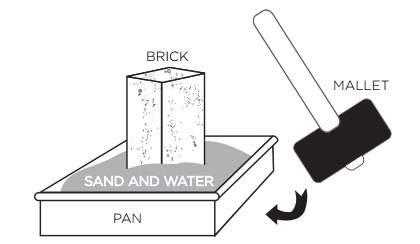In this activity, students explore how vibrations can make solid ground unstable.
Liquefaction is a phenomenon in which the strength and stiffness of a soil is reduced by earthquake shaking or other rapid loading. Liquefaction occurs when vibrations from seismic waves increase water pressure between soil grains, transforming once cohesive soil into a slurry of mud!
Liquefaction is more likely to occur in loose to moderately saturated granular soils with poor drainage, such as silty sands or sands and gravels. If the pressure of the water between soil grains is great enough, it will have the effect of holding the particles apart and of producing a condition that is practically equivalent to that of quicksand.
Liquefaction and related phenomena have been responsible for tremendous amounts of damage in historical earthquakes around the world. The building codes in many countries require engineers to consider the effects of soil liquefaction in the design of new buildings and infrastructure such as bridges, embankment dams and retaining structures
